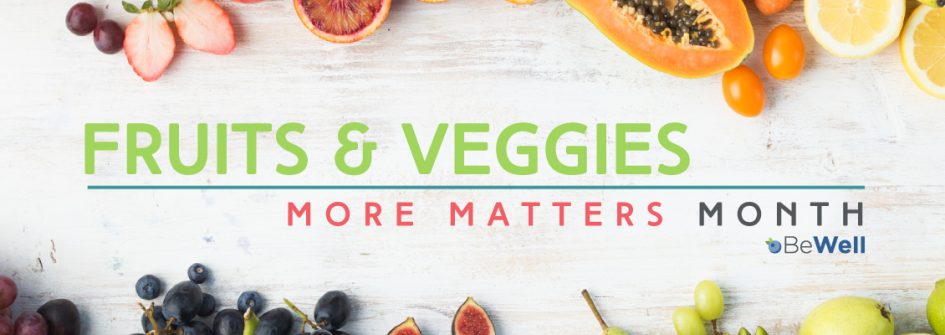Fruits & Veggies | More Matters Month
September is Fruit and Vegetable month! A great way to celebrate this month is to learn the facts and reflect upon our own habits. Nationally, only 1 in 10 adults meet the federal recommendations for fruit and vegetable consumption. According to the Centers for Disease Control (CDC), on average, only 12.2% of adults meet the daily fruit intake recommendation of 1½ to 2 cups per day, and only 9.3% of adults meet the daily vegetable intake recommendation of 2 to 3 cups per day!
Risks related to underconsumption of fruits and vegetables:
- heart disease
- stroke
- diabetes
- high blood pressure
- digestive disorders
- vision problems
- lack of protection against certain cancers
- obesity
- and more!
Consuming fruits and vegetables is important for disease prevention and health. Fruits and vegetables are beneficial to us by providing essential nutrients, such as Vitamin C, Vitamin A, fiber, potassium, and folate, which can help with a healthy heart and a happy digestive tract. Follow the tips below to overcome some common barriers to eating more fruits and vegetables.
BUSY LIFESTYLE
- Wash, chop, and store vegetables right after grocery shopping to be used in meal prep later
- Choose fruits such as apples, bananas, and oranges that can be taken with you on the go
- Prepare to go sandwiches that include cucumbers, tomatoes, roasted red peppers, and other complimentary vegetables
- Keep cut up vegetables on hand such as carrots, celery, and peppers for quick snacks
- Use pre-cut frozen vegetables that just need heated
ON A BUDGET
- Preparing meals at home saves money
- Incorporate frozen, canned, and dried forms of fruits and vegetables as they are convenient and just as nutritious as fresh versions
- Choose recipes such as soups or casseroles that can be consumed multiple times throughout the week or frozen for later use
- Buy fruits and vegetables when they are in season as some can be less expensive
- Buy in bulk when produce is on sale
- Plant a garden and grow your own vegetables
Recipe: Tuscan Spaghetti Squash With Kale
This recipe is veggie packed! Not only are you getting an abundance of vitamins and minerals in this dish, but also a full blast of flavor. If you are not into the spaghetti squash, you could always switch it out for zucchini noodles known as “zoodles” or whole grain pasta noodles as an alternative. This dish would be great for a meatless Monday dinner entrée.
Serving Side: 1 ½ cup Spaghetti Squash with 1 cup sauce | Yield: 4 servings | Method: Bake and Cook
Ingredients:
28 oz Spaghetti squash, cooked and removed from flesh
1 tbsp Olive oil
2⁄3 cup Yellow onion, fresh, diced
2⁄3 cup Roasted red pepper, strips
2 tsp Garlic, chopped
5 cup Kale, baby
1 tsp Red pepper, flakes
1¾ cup Tomatoes, fresh, diced
1 cup Vegetable broth
11⁄3 cup Bean, cannellini drained
4 tbsp Black olives ripe, sliced
4 tbsp Parmesan cheese, shredded
4 tbsp Basil, fresh, chiffonade
¼ tsp Salt
1 tsp Black pepper
Instructions:
- Prepare spaghetti squash (see instructions below). Approximately 4 pounds of whole, uncooked spaghetti squash will yield 28 oz or 6 cups of cooked squash without skin and other refuse.
- Heat oil over medium heat. Sauté onion until softened, 3–5 minutes.
- Stir in red peppers and garlic. Add kale and cook until wilted. Stir in basil and red pepper.
- Add tomatoes, broth and beans. Season with ¼ tsp salt and ¾ tsp pepper.
- Bring to boil and cover. Reduce heat and simmer for 10–15 minutes, just enough to soften tomatoes and reduce liquid by a third to one half.
- Dish out 1½ cups of squash per serving and top with 1 cup of sauce. Sprinkle with 1 tbsp of each: black olives, parmesan cheese and fresh basil.
Spaghetti Squash Noodle Directions:
- Preheat oven to 350°F.
- Cut the squash in half lengthwise, scoop out the seeds with a spoon. Alternatively, you can bake the squash whole, which makes it easier to cut.
- Sprinkle with ¼ tsp pepper and place on baking sheet, cut side down.
- Bake about an hour, or until the skin gives easily under pressure and the inside is tender. Remove from oven, let cool 10 minutes. If cooking whole, turn squash after 30 minutes.
- Using a fork, scrape out the squash from the flesh a little at a time, it will separate into spaghetti-like strands
UW-W DINING SERVICES

Leave a Reply